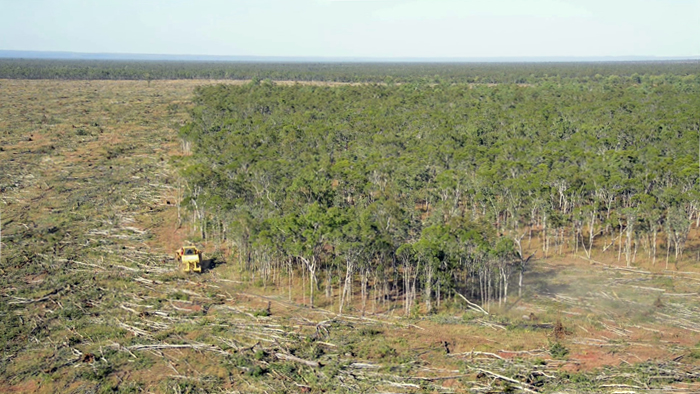Governments claiming to be “meeting and beating” emissions targets are getting away with daylight robbery.

Land-clearing has been proceeding at a record pace in Queensland since restrictions were relaxed in 2013. PHOTO Kerry Trapnell/The Wilderness Society
For decades, statistics around forests, forestry and land-clearing have been the blunt instrument of choice to support all sides of the climate debate in Australia.
In 1997 the Howard government successfully argued that the carbon emissions “saved” from a reduced rate of land-clearing during the 1990s should be counted when assessing Australia’s progress towards its Kyoto target.
The “Australia clause” in the Kyoto agreement relied on government land-clearing data and relatively limited scientific knowledge about the capacity of different natural and cultivated plant communities to take up carbon.
While the science has improved, land use remains a fuzzy area in carbon accounting. Most political claims about emissions employ land-use data. They must be treated with caution, if not suspicion.
Hailed at the time as a political and diplomatic triumph, the Australia clause has enabled successive national and state governments to conceal a continuing chronic failure to even address, let alone reduce, fossil fuel emissions.
Since abolishing Australia’s carbon price scheme – the only enacted measure so far that has demonstrably cut such emissions – the federal government has repeatedly employed land-use data to support its claim that it is on track to “meet and beat” its 2020 and 2030 targets.
Tasmanian emissions reductions are almost entirely dependent on native forests not being harvested. That is the basis of the Hodgman government’s claim that Tasmania leads the world in reducing emissions, and its recent election promise commit to zero net emissions by 2050.
The government’s “Climate Action 21” strategy doesn’t explain how this will be done unless the native forest logging sector remains moribund. Yet it has also promised to double income from forest production by 2036. It doesn’t seem to bother the government that the two cannot possibly co-exist.
A similar scenario is in play in Queensland, except that the end goal there is not to harvest wood but to clear land. And Queensland is pretty good at clearing land; that state alone accounts for more than half the nation’s total native forest clearance.
The implication behind the federal government’s argument at the 1997 Kyoto climate summit was that land clearing rates would continue to be suppressed. For a while it looked as if that might put a permanent brake on clearing natural landscapes in this country.
But for many Australians tree clearing is synonymous with life on the land. A large cohort of conservative politicians in Brisbane and Canberra, most or all of them disbelieving the science behind the Kyoto agreement, lobbied long and hard to have restrictions lifted.
They finally got their wish when a Liberal-National government watered down the rules early in 2013. In that year Queensland’s land-clearing rate was 261,000 hectares. By 2015-16, when the figure was 395,000 hectares, the state had seen over a million hectares cleared within four years.
A newly re-elected Labor government is now seeking parliamentary approval for new laws restricting clearing. Environment Minister Leeanne Enoch justified the action in terms of conserving natural values and helping Australia meet its climate commitments.
The proposed new laws are getting a predictable response from defenders of the status quo, who demand to know why “scrubby” forest should be protected when it could be replaced with “lush productive farm land”.
That reflects a general attitude among some farmers and their political representatives that clearing land is, by definition, improving it. Many have claimed that this extends to carbon storage – that replacing native bush with crops and pastures improves the land’s carbon-carrying capacity.
Nothing could be further from the truth. The Turnbull government’s Office of the Chief Scientist advises that dry natural forests provide better long-term storage than grasslands, and that per hectare, “forests are typically more than ten times as effective [at storing carbon] as grasslands”.
The lesson should be clear to governments and landowners alike. Removal of established native forest, whether for pasture or for crops (including trees), reduces the land’s capacity to hold carbon while also making it less able to retain moisture.
Economics is already starting to sort this out. As dry-land farmers are learning the downside of land-clearing, Tasmania’s plantation timber industry has worked out many ways to make money from wood fibre without intruding into native forests.
Any government intent on effective climate action, while working hard to cut fossil fuel emissions, would severely limit land clearing and would not even contemplate old-growth logging. There are huge credibility gaps here, and no sign they are about to be closed.
